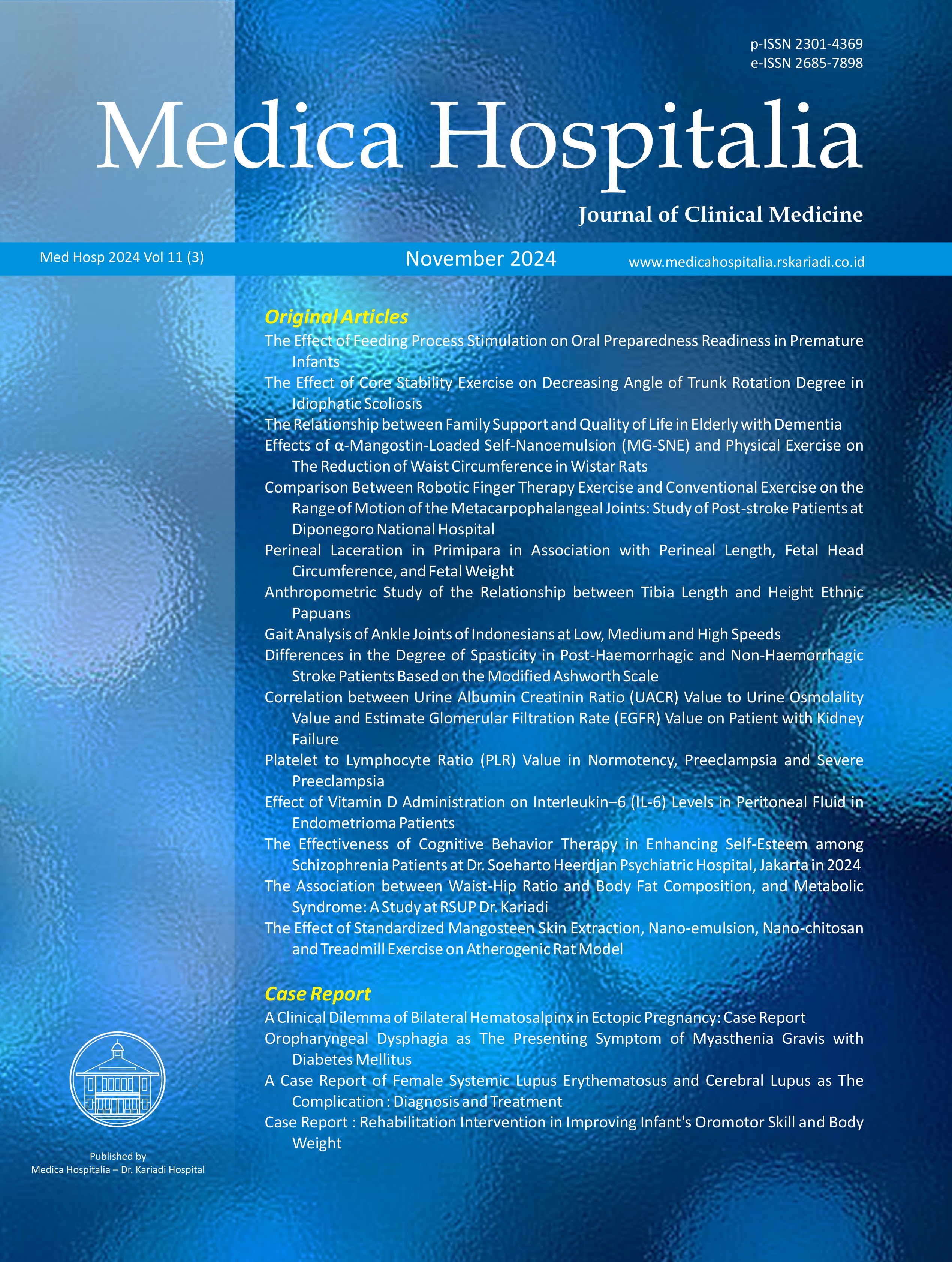Radiologic Severity Index (RSI) Score in COVID-19 Patients After Administration of Remdesivir: A Study on High CRP and D-dimer Levels in a Group of Patients
DOI:
https://doi.org/10.36408/mhjcm.v12i1.1012Keywords:
COVID-19, CRP, D-Dimer, RSI Score, RemdesivirAbstract
BACKGROUND: The COVID-19 pandemic has high mortality and morbidity. The lungs are the main target organ with a variety of symptoms ranging from asymptomatic to respiratory failure. Chest X-ray plays an important role in diagnosis, management, and prognosis. One of the chest X-ray assessment systems used is the Radiology Severity Index (RSI). Serum CRP and D-dimer levels can also be used to determine the severity of COVID-19.
AIM: To examine changes in RSI scores after remdesivir therapy in COVID-19 patients with high CRP and D-dimer values.
METHOD: A prospective cohort study of 64 COVID-19 patients at Dr. Kariadi Hospital Semarang from July 2020 to July 2021. Each consisted of 32 patients with high CRP (>5 mg/L) and D-dimer (>500 ng/mL) levels. Patients were given Remdesivir 200 mg therapy on day 1, followed by 100 mg/day until day 9. Chest X-rays were performed before and on day 7 after initial therapy. Patients with CHF, malignancy, autoimmune, pulmonary TB, interstitial lung disease and receiving azythromycin therapy were excluded from the study. Correlation analysis between variables was performed using the Spearman rho test and comparison test between groups. Significant results if p <0.05.
RESULT: There was a significant decrease in the RSI score of COVID-19 patients with high CRP and D-dimer levels after therapy, from 21.97±16.88 and 21.22±19.92 to 15.69±14.12 and 15.78±15.69, respectively (p<0.001). There was a weak significant relationship between high CRP levels and pre-therapy RSI scores (r=0.473, p=0.006) and high D-dimer levels and post-therapy RSI scores (r=0.362, p=0.041).
CONCLUSION: Remdesivir provides a significant correlation in the form of a decrease in RSI scores in COVID-19 patients with high CRP or D-dimer levels.
Downloads
References
1. ACR Recommendations for the use of Chest Radiography and Computed Tomography (CT) for Suspected COVID-19 Infection [Internet]. American College of Radiology. 2020 [cited 2023 Mar 20]. Available from: https://www.acr.org/Advocacy-and-Economics/ACR-Position-Statements/Recommendations-for-Chest-Radiography-and-CT-for-Suspected-COVID19-Infection
2. Hosseiny M, Kooraki S, Gholamrezanezhad A, Reddy S, Myers L. Radiology Perspective of Coronavirus Disease 2019 (COVID-19): Lessons From Severe Acute Respiratory Syndrome and Middle East Respiratory Syndrome. Cardiopulm Imaging. 2020;215:1–5.
3. Coronavirus disease 2019 [Internet]. World Health Organization. 2019 [cited 2023 Mar 20]. Available from: https://www.who.int/emergencies/diseases/novel-coronavirus-2019
4. Kazerooni EA. High-Resolution CT of the Lungs. AJR. 2001;177:501–19.
5. Susilo A, Rumende CM, Pitoyo CW, Santoso WD, Yulianti M, Sinto R, et al. Coronavirus Disease 2019: Tinjauan Literatur Terkini. J Penyakit Dalam Indones. 2020;7(1):45–67.
6. Zhou F, Yu T, Du R, Fan G, Liu Y, Liu Z, et al. Clinical course and risk factors for mortality of adult inpatients with COVID-19 in Wuhan, China: a retrospective cohort study. Lancet [Internet]. 2020;395(10229):1054–62. Available from: http://dx.doi.org/10.1016/S0140-6736(20)30566-3
7. Patel SK, Adhikari S, Gauli B, Bhattarai MD, Paudel B, Adhikari D, et al. Association of CRP and D-dimer with CT Severity Scoring in COVID-19 Patients. J Chitwan Med Coll. 2021;11(38):120–5.
8. Chen Y, Liu Q, Guo D. Emerging coronaviruses: Genome structure, replication, and pathogenesis. J Med Virol. 2020;92:418–23.
9. Fachri M, Hatta M, Widowati E, Akaputra R, Dwiyanti R, Syukri A, et al. Correlations between comorbidities, chest x-ray findings, and C-Reactive protein level in patients with COVID-19. Ann Med Surg [Internet]. 2022;77(103553):1–5. Available from: https://doi.org/10.1016/j.amsu.2022.103553
10. Sun J, He W, Wang L, Lai A, Ji X, Zhai X, et al. COVID-19: Epidemiology, Evolution, and Cross-Disciplinary Perspectives. Trends Mol Med [Internet]. 2020;26(5):483–95. Available from: https://doi.org/10.1016/j.molmed.2020.02.008
11. Tanni SE, Silvinato A, Floriano I, Pneumologia D De. Use of remdesivir in patients with COVID-19: a systematic review and meta-analysis. J Bras Pneumol. 2022;48(1):1–13.
12. Udugama B, Kadhiresan P, Kozlowski HN, Malekjahani A, Osborne M, Li VYC, et al. Diagnosing COVID-19: The Disease and Tools for Detection. ACS Nano. 2020;14:3822–35.
13. Sari EF, Rumende CM. Factors related to Pneumonia Diagnosis in Elderly [Faktor – Faktor yang Berhubungan dengan Diagnosis Pneumonia pada Pasien Usia Lanjut]. J Penyakit Dalam Indones. 2016;3(4):183–92.
14. Laffan M MR. Investigation of thrombotic tendency. In: Lewis SM, Bain BJ BI, editor. Dacie and Lewis Practical Haematology. 10th ed. Philadephia: Churcill Livingstone; 2006. p. 441–64.
15. AC H. D-dimer testing and acute venous thromboembolism. Inst Transfus Med Updat. 2000;
16. Pan F, Ye T, Sun P, Gui S, Liang B, Li L. Time Course of Lung Changes On Chest CT During Recovery From 2019 Novel Coronavirus (COVID-19) Pneumonia. Radiology. 2020;
17. Herdiman H, Basyar M, Khairsyaf O. Association Between D-Dimer Level with Clinical Severity and Radiological Imaging of Confirmed COVID-19 Patients at RSUP Dr. M. Djamil Padang. J Respir Indo. 2022;42(4):328–34.
18. Geetika P, J MV, Suresh A, Sudhanva N. Correlation Of Chest X-Rays With Lab Parameters In Covid-19. Eur J Mol Clin Med. 2022;09(04):1911–20.
19. Sofic A, Cizmic M, Beslagic E, Becirevic M, Mujakovic A. Brixia Chest X-ray Severity Scoring System is in Relation with C-reactive Protein and D-dimer Values in Patients with COVID-19. Mater Sociomed. 2022;34(2):95–9.
Additional Files
Published
How to Cite
Issue
Section
Citation Check
License
Copyright (c) 2025 Adhi Rommy Setyawan, Bambang Satoto, Sofyan Budi Raharjo, Christina Hari Nawangsih, Hermina Sukmaningtyas, Nurdopo Baskoro (Author)

This work is licensed under a Creative Commons Attribution-ShareAlike 4.0 International License.
Copyrights Notice
Copyrights:
Researchers publishing manuscrips at Medica Hospitalis: Journal of Clinical Medicine agree with regulations as follow:
Copyrights of each article belong to researchers, and it is likewise the patent rights
Researchers admit that Medica Hospitalia: Journal of Clinical Medicine has the right of first publication
Researchers may submit manuscripts separately, manage non exclusive distribution of published manuscripts into other versions (such as: being sent to researchers’ institutional repository, publication in the books, etc), admitting that manuscripts have been firstly published at Medica Hospitalia: Journal of Clinical Medicine
License:
Medica Hospitalia: Journal of Clinical Medicine is disseminated based on provisions of Creative Common Attribution-Share Alike 4.0 Internasional It allows individuals to duplicate and disseminate manuscripts in any formats, to alter, compose and make derivatives of manuscripts for any purpose. You are not allowed to use manuscripts for commercial purposes. You should properly acknowledge, reference links, and state that alterations have been made. You can do so in proper ways, but it does not hint that the licensors support you or your usage.
























